How do we develop our daily living consumable tastes? I have no idea. But I’ve been using Ban-brand antiperspirant for as long as I can remember, the unscented variety, as I’ve no wish to smell like “fresh cotton” or “satin breeze,” two of their other varieties. Here’s a photo I took in a Boston hotel in 2012 showing it as part of my gels-and-fluids collection in my luggage, along with toothpaste, hand sanitizer, gold printing ink and lip balm.
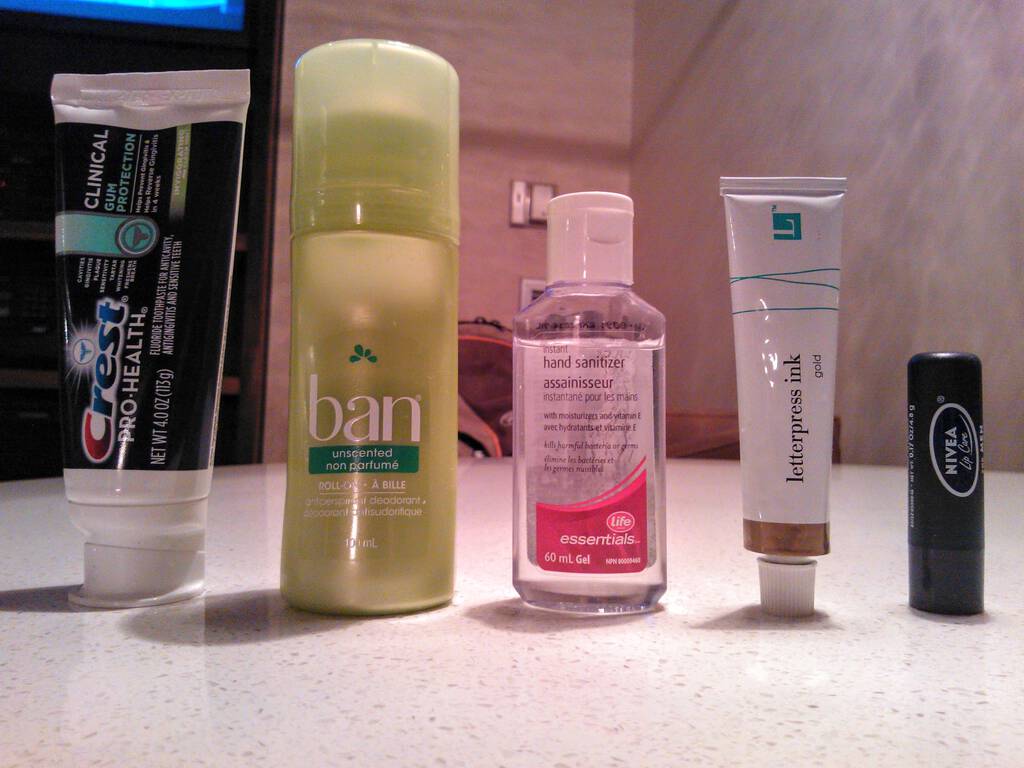
I’ve had difficulty locating Ban Unscented for the last year or so: sometimes it’s available a Sobeys or Shoppers Drug Mart and sometimes it’s not, and, more often than not, if it is available it’s only in “powder fresh” scent.
Ban is a brand of the Japan-based multinational Kao Corporation, which also owns other familiar brands like Curel, Biore, and Jergens. In other words, it’s not a small-batch artisanal deodorant maker.
Last I decided to get to the bottom of the apparent Ban ban on PEI and used the contact form on the Ban website to send a query. The initial response, an automated one, was curious for its inclusion of this mystical incantation:
In addition, please be advised that for increased efficiency, we use message preview panes that allow us to read your message without actually opening it. If you track how your messages are handled, you may get a message that states that your message was deleted without being read. Due to how we operate, the tracking message will not be accurate. You can be confident that we read all correspondence that we receive.
Including that smacks of a “someone thought we deleted their email before we read it — get through to legal and make sure we’re protected!!” exchange at corporate. Regardless, this morning came the reply:
We are sorry that you are having difficulty locating our product.
Our products are now sold online only through Walmart.ca and amazon.ca.
Unfortunately, we are not able to sell directly to consumers due to licensing issues.
We hope this information is useful and we look forward to your continued interest in our products.
Sure enough, Amazon sells Ban Unscented for $8.17/container, and Walmart sells it for $3.98/container.
Has it come to this? Must I really go to Walmart for my deodorant?
How difficult it is to find non-payola mattress reviews online is perhaps the clearest example of how how the commercial internet fails us. At the same time, in a not-unrelated development, mattress technology and marketing has changed dramatically in the 15 years since I last bought a mattress, with the arrival of the compressed-bed-in-a-box disrupters and their “why do you need a showroom when we let you try it for 100 nights?!” entreaties.
I’ve a feeling my mattress is slowly killing me in my sleep: it’s a old school, not particularly well-made king size coil mattress set on a pair of twin box springs. From an earlier time. I have never loved it, perhaps in part because my experience of it before it was wrangled up our stairs by burly delivery drivers was a 10 minute test drive at Sears. For a time it was set on a prison-like wooden bed frame that ultimately fell apart; in recent years it’s just sitting on the floor.
So, dear readers, tell me about your mattress if you will. Where did you buy? What style? How did you choose? How do you sleep? Every body is different, yes; but I need to get the lay of the land in a forum outside of the influencer echo chamber.
I am into my fourth year of making regular voluntary blood plasma donations at the Canadian Blood Services centre in Charlottetown.
Truth be told, I’ve been at it for longer than that, but I fell into a lapse for an awfully long time simply because, at the time, the mechanisms for “donor engagement” were weak, and I stopped getting reminders to make appointments.
In the intervening years things have improved dramatically, and there’s now an excellent, useful website and an excellent, useful mobile app to support donors, combined with a full-court press WUPHF-style ”we’re going to remind you in all possible media” engagement effort that makes it next to impossible to drop off.
One of the things the updated website sports is a “Bleed Times” chart that shows the time it took to donate–or at least the “harvesting” phase thereof–with the option to export the image, or the data underlying. Here’s mine, showing donations from 2018 to present:
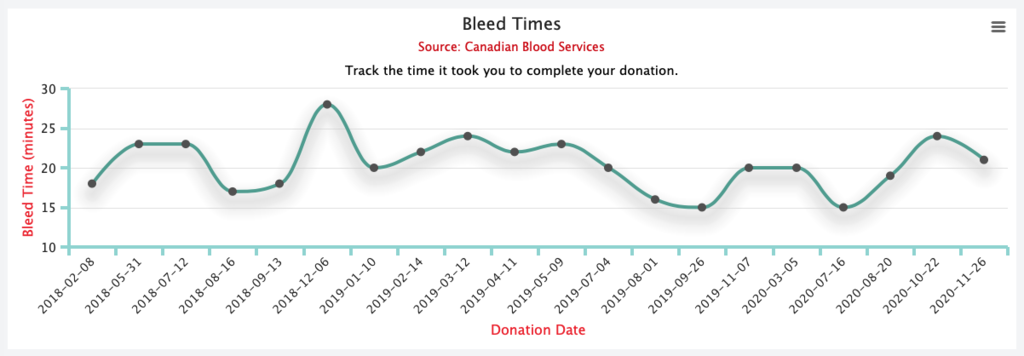
The standard plasma donation is 500 ml. There’s a cycle to the donation process: blood is removed, plasma extracted, and blood returned. Each cycle takes 5 to 6 minutes, and, depending on a number of conditions, sometimes it takes two cycles to complete the 500 ml donation, sometimes it takes three, and, in rare occasions, four. That’s why the bleed time varies from 15 minutes to almost 30 minutes.
The donor centre in Charlottetown has been open throughout the pandemic (they were closed at the very beginning for plasma donations, but have been reopened fully since the summer). As with everything else in public life, they have new protocols in place to mitigate COVID-19 transmission: mask wearing, plexiglass barriers, a reduced set of pre-screening operations (they no longer take your blood pressure or your weight).
Despite these enhancements, donating plasma remains remarkably easy and, if not “painless,” at least limited to a few very quick, skilfully-executed jabs. I’m generally in, pre-screened, and have completed my donation in under an hour.
There are plasma donation centres in St. John’s, Charlottetown, Halifax, Saint John, London, Sudbury, Edmonton and Calgary, and you can make an appointment quickly and easily online.
Remember the Geese, from Karine Polwart and Pippa Murphy.
We are each other’s wind resistance, a human skein. And we’re not going to make it on our own.
A poem by Heather Christle, anthologized in Set Me On Fire: A Poem for Every Feeling, by Ella Risbridger.
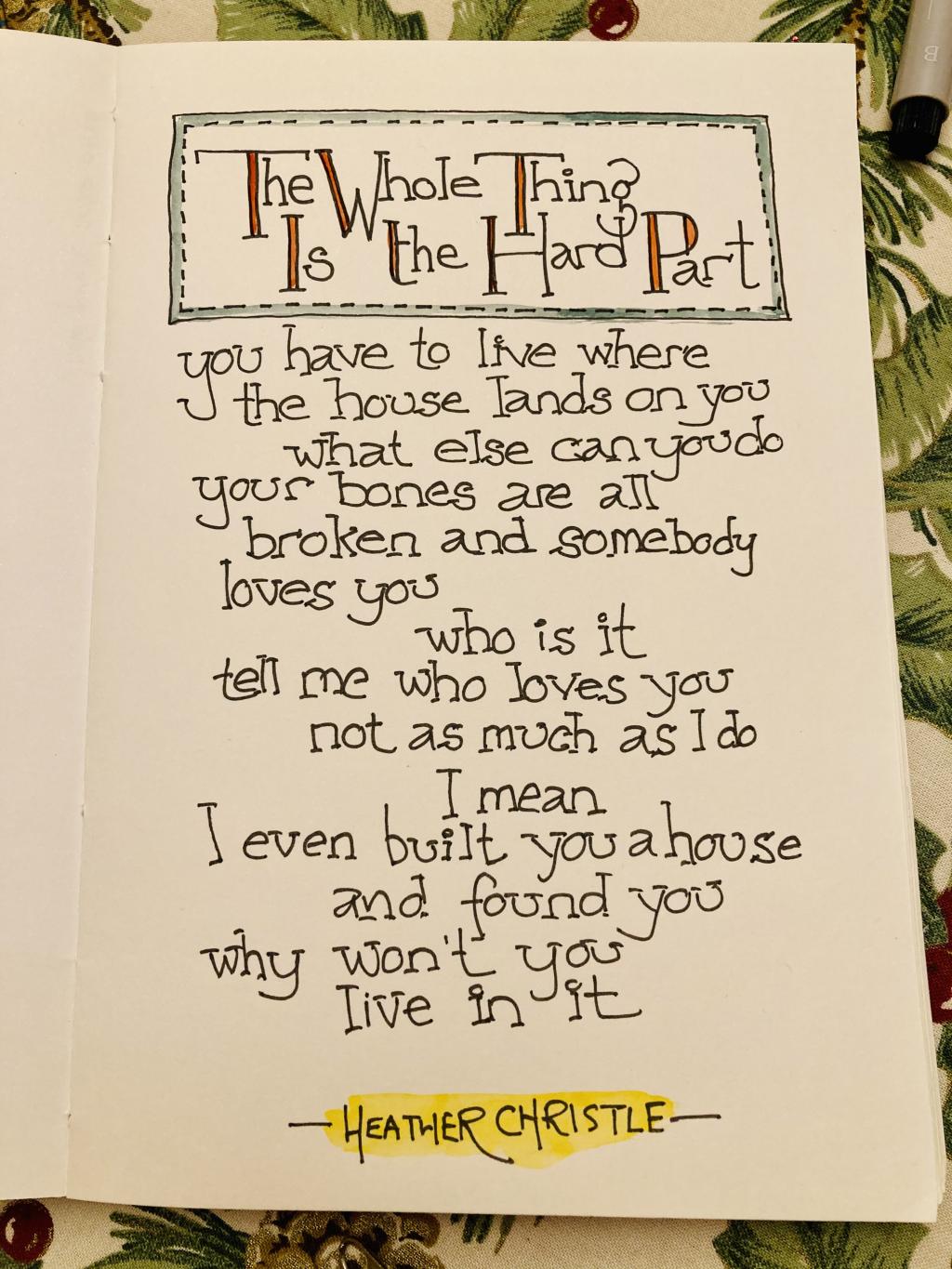
At the beginning of every drop-in grief support group I’ve been to we’ve started with the reciting of “Our Promise,” which is a very helpful scene-setting for the hour following:
Our Promise
This is a safe, welcoming place.
What is spoken here, stays here.
Share only as much as is comfortable for you.
Listening to others is a good growth experience.
If you feel pressure to talk and don’t feel like it, say so.
Your story is true and unique and not open to comparison.
We will avoid giving advice.
We will listen and not interrupt.
Each of us has equal time, we do not monopolize.
Your spirituality and belief system is yours and is to be honored.
The group will begin and end on time.
Thoughts and feelings are neither right nor wrong, they just are.This is a support group, not a therapy group.
Support means I will walk with you.
I will not try to change you or how you feel.
I will simply be here beside you.
Reading this in the clear light of day, it strikes me as valuable guiding words for any group, grief-involved or not. Or, indeed, for a romantic partnership.
One of the downsides of our patrilineal naming scheme is that I have tended to identify more with my father and my father’s father, and so on, following the line Rukavinas back in history. Talking with my mother over the holidays reminded me of the folly of this lopsidedness, and so I started to peer down my maternal line.
While having the last name Rukavina is, in the Prince Edward Island context, a semaphore for “not from around here,” that my mother descends from Scottish and Irish immigrants means that I’m likely more of here than not. I’m as much Scottish as I am Croatian, genetically-speaking; and as much Ukrainian and Irish too.
My mother’s mother was a Fraser from Ontario; her mother was a Mathison, whose mother was a Rae, whose mother was Ann Dryden (which is one of our two connections to Canadian hockey royalty).
Following the Dryden line back to into deepest Scotland, thanks to the genealogy obsession of the Mormons, proves remarkably easy, and so I’m able to identify my great-great-great-great-great-great-great-great-great-great-great-great-grandfather as Alan Cochrane of that Ilk, born 1432 in Paisley, Renfrewshire, Scotland.
As you might imagine, having a relation whose name includes “of that Ilk” is rather delightful to me.
Also in my family tree are William “The Notorious Intriguer” Cunningham, Baroness Isobel Moncrieff, Sir Lord Archibald “Bell the Cat” Douglas, Lady Margaret Catherine Hoppringle (and isn’t that a delightful last name).
According to Rootsweb, 12 generations back I have 8,190 grandparents with a ballpark 705,588 descendants. So, in other words, I have no rightful exclusive claim to use “of that Ilk” or “The Notorious Intriguer” as part of my name.
But I’m likely related, thus, to many of my fellow Islanders at some point in the family tree.
I was lucky to receive a discarded calendar featuring vintage tourism posters from across Canada. I immediately set to reviving my bookbinding practice, making a coptic-stitched sketchbook from the “Toronto” page. I’m quite rusty, so this was more a beta test than anything; I’d forgotten how much I love book making, and I’ve already started on another, this time using a map of the area around Mbarara, Uganda that I rescued from the University of Calgary Library in 2014.
I found the videos Coptic Stitch Journal Tutorial! and DIY Coptic Stitch Bookbinding Tutorial helpful in reminding me of the stitching pattern; they compliment each other, and if you’re going to try your hand, I’d recommend watching both.
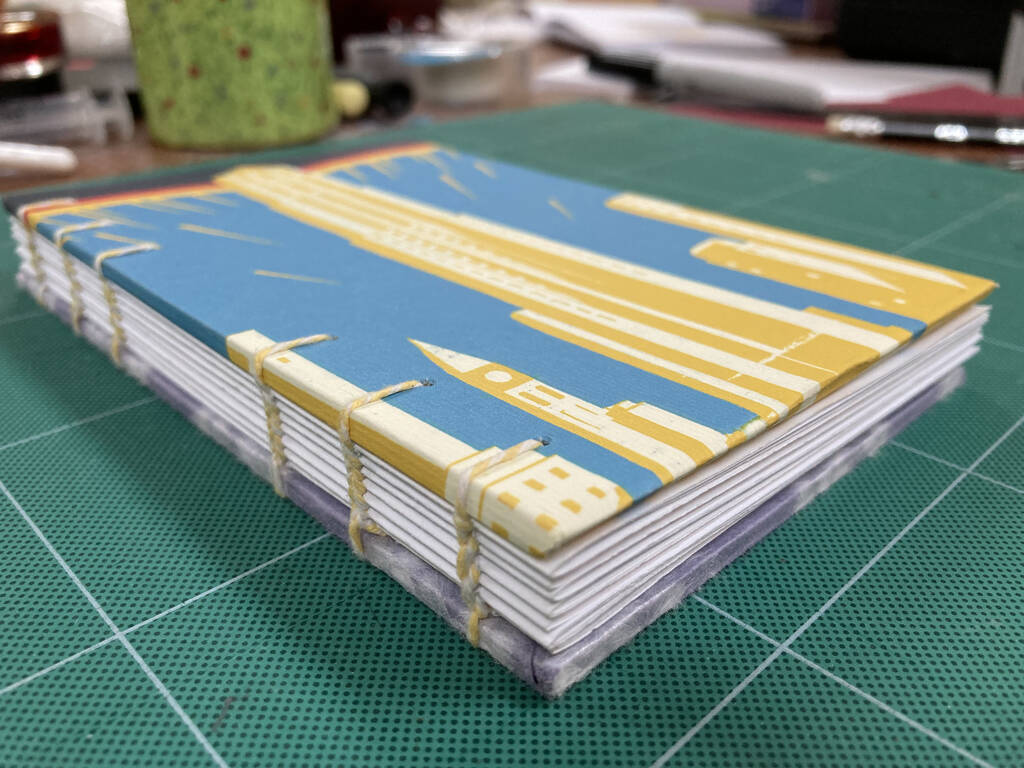
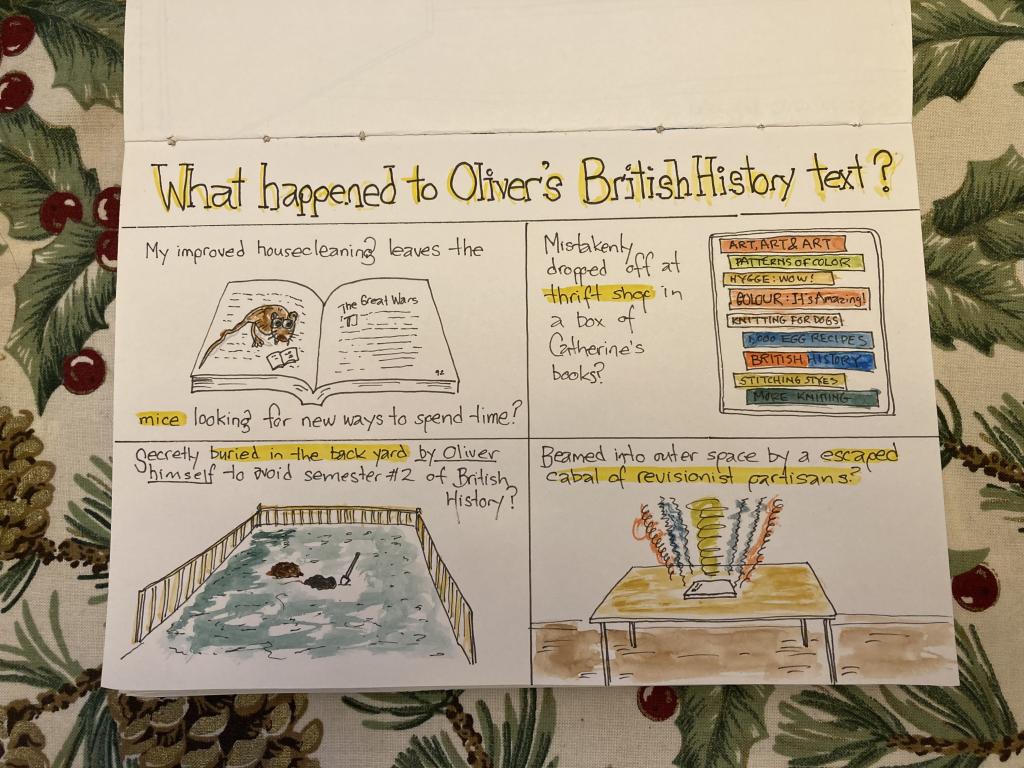

 I am
I am